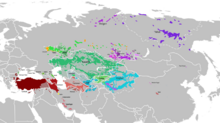
Turkic peoples
Family of ethnic groups of Eurasia / From Wikipedia, the free encyclopedia
Dear Wikiwand AI, let's keep it short by simply answering these key questions:
Can you list the top facts and stats about Turkic peoples?
Summarize this article for a 10 year old
The Turkic peoples are a collection of diverse ethnic groups of West, Central, East, and North Asia as well as parts of Europe, who speak Turkic languages.[37][38]
According to historians and linguists, the Proto-Turkic language originated in Central-East Asia,[39] potentially in Altai-Sayan region, Mongolia or Tuva.[40][41][42] Initially, Proto-Turkic speakers were potentially both hunter-gatherers and farmers; they later became nomadic pastoralists.[43] Early and medieval Turkic groups exhibited a wide range of both East Asian and West-Eurasian physical appearances and genetic origins, in part through long-term contact with neighboring peoples such as Iranic, Mongolic, Tocharian, Uralic and Yeniseian peoples.[44]
Many vastly differing ethnic groups have throughout history become part of the Turkic peoples through language shift, acculturation, conquest, intermixing, adoption, and religious conversion.[1] Nevertheless, Turkic peoples share, to varying degrees, non-linguistic characteristics like cultural traits, ancestry from a common gene pool, and historical experiences.[1] Some of the most notable modern Turkic ethnic groups include the Altai people, Azerbaijanis, Chuvash people, Gagauz people, Kazakhs, Kyrgyz people, Turkmens, Turkish people, Tuvans, Uyghurs, Uzbeks, and Yakuts.
